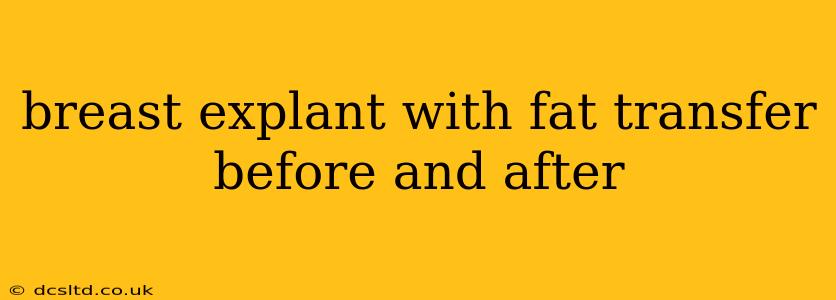Breast implant removal followed by fat grafting, often called a breast explant with fat transfer, is a popular procedure for women seeking a more natural breast shape and improved breast health. This procedure combines the removal of breast implants with the transfer of the patient's own fat to reconstruct the breasts. The results can be incredibly natural-looking, restoring volume and contour while eliminating the potential complications associated with breast implants. This comprehensive guide explores the before and after aspects, key considerations, and what you can expect from this transformative procedure.
What to Expect Before the Procedure:
Before undergoing a breast explant with fat transfer, a thorough consultation with a qualified plastic surgeon is essential. This consultation will include:
- Medical History Review: Your surgeon will review your complete medical history, including any previous surgeries, medications, and allergies.
- Physical Examination: A physical examination will assess your breast tissue, skin elasticity, and overall health.
- Imaging: Imaging studies, such as an ultrasound or mammogram, may be recommended to assess the implant placement and surrounding tissues.
- Discussion of Goals and Expectations: Openly discuss your aesthetic goals and realistic expectations with your surgeon. They will help you understand the potential outcomes and limitations of the procedure.
- Pre-Operative Instructions: You’ll receive detailed instructions regarding pre-operative preparation, such as dietary restrictions and medications to avoid.
The Surgical Process:
The procedure typically involves two main stages: implant removal and fat grafting.
- Breast Implant Removal: The surgeon makes incisions (location depends on the type of implant and original surgery) to access and remove the breast implants. Capsular contracture (scar tissue around the implant) is addressed during this stage.
- Fat Harvesting (Liposuction): Fat is harvested from other areas of the body, commonly the abdomen, thighs, or hips, using liposuction techniques. The fat is then processed to remove excess fluid and impurities.
- Fat Transfer (Grafting): The purified fat is carefully injected into the breasts to restore volume and shape. The surgeon uses precise techniques to achieve a natural-looking result.
What to Expect After the Procedure:
The recovery process varies depending on individual factors and the extent of the surgery. You can expect:
- Swelling and Bruising: Swelling and bruising are common and typically subside within several weeks.
- Discomfort: Some discomfort is normal and can be managed with pain medication.
- Compression Garments: You’ll likely need to wear compression garments for several weeks to support the breasts and minimize swelling.
- Follow-up Appointments: Regular follow-up appointments are necessary to monitor healing and address any concerns.
What are the Potential Risks and Complications?
While generally safe, breast explant with fat transfer carries potential risks and complications, including:
- Infection: As with any surgical procedure, there's a risk of infection.
- Hematoma (blood clot): A blood clot can form at the surgical site.
- Seromas (fluid collection): Fluid may accumulate under the skin.
- Fat Necrosis (fat cell death): Some of the transferred fat may not survive.
- Asymmetry: Achieving perfect symmetry is challenging, and some asymmetry may remain.
- Unsatisfactory cosmetic results: Results may not meet individual expectations.
It is crucial to discuss these potential risks and complications with your surgeon before proceeding.
How Long Do the Results Last?
The longevity of the results depends on several factors, including the patient's body type, lifestyle, and the amount of fat that survives the grafting process. While a significant portion of the transferred fat is typically absorbed, a considerable amount remains permanently. The surgeon will provide a realistic estimate of the long-term outcome during your consultation.
How Much Does a Breast Explant with Fat Transfer Cost?
The cost of a breast explant with fat transfer varies widely depending on the surgeon's fees, facility costs, geographic location, and the extent of the procedure. It's important to obtain a detailed cost breakdown from your surgeon before proceeding.
Is Breast Explant with Fat Transfer Right for Me?
This procedure is a good option for women who:
- Are unhappy with their breast implants.
- Experience symptoms associated with breast implants (e.g., pain, capsular contracture).
- Desire a more natural breast appearance.
- Have sufficient fat for grafting.
It's crucial to have a thorough consultation with a qualified plastic surgeon to determine if this procedure is suitable for your individual circumstances.
Can I combine a breast lift with this procedure?
Yes, a breast lift (mastopexy) can often be combined with breast explant and fat transfer, particularly if significant breast sagging is present. This approach provides comprehensive breast rejuvenation. This should be thoroughly discussed with your surgeon to determine if it's appropriate for your needs.
Remember, this information is for general knowledge and does not constitute medical advice. Always consult with a qualified plastic surgeon to discuss your individual needs and determine if breast explant with fat transfer is the right procedure for you.
